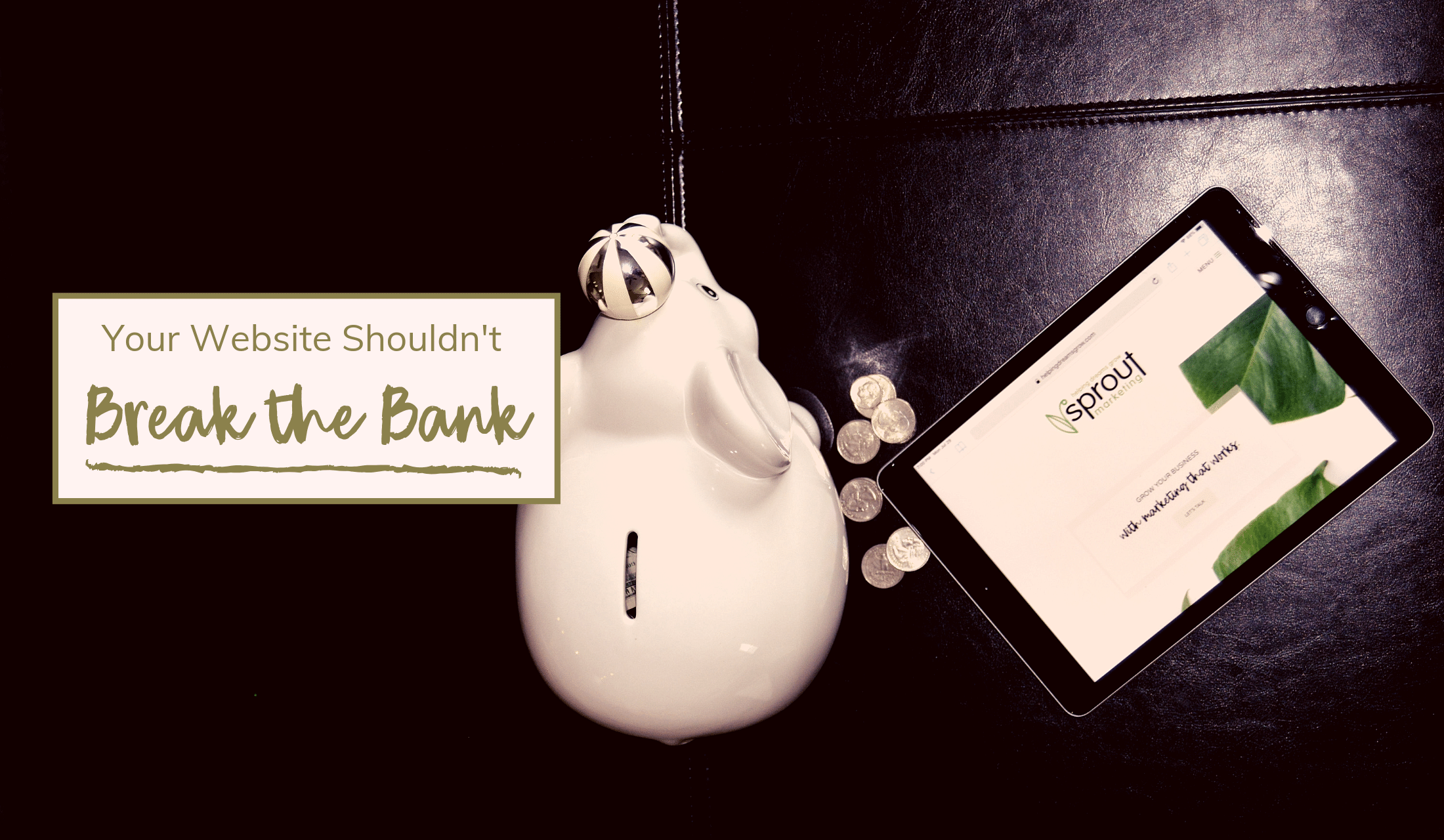
When you think of your website, it’s hard not to see dollars signs – everywhere. And that can be overwhelming. I’ve been there too. Whether you’re launching a new website or need a website redesign, both take some level of financial funding. That’s why I’m sharing these simple tips on navigating website costs so you can make the most of your resources and feel confident with your launch.
Before we get to the juicy part and talk about money, we must cover one thing. Who’s going to do the work? Yep, that one little question changes it all. Why? Because a hired professional and the type of expertise they provide can impact costs. Just be prepared to budget for that cost.
Ready to get started? Let’s grow!
Do Your Own Website Design
The most cost-efficient option is DIY. No longer the impossible task, sites such as Squarespace, Wix, GoDaddy, or Weebly exist to help you create a stunning website. Many are free or offer a pricing plan based on enhanced services you may need or want.
I applaud these companies for helping anyone get an affordable website they need and deserve. Now, is it the right option for you? That’s another question. Here’s what I recommend you consider first.
- Objective – Assess your website’s purpose, and determine if you or someone on your team can use one of these sites to reach your goals. For example, if you’re a solopreneur and mainly blogging or using networking for your leads, a DIY site can be a great option. However, if your business depends on generating leads or selling products on the site, you may need to invest in the right expertise.
- Time – This option is by far the most time-consuming one. You or someone on your team must do all the work, which can take away from other tasks. Can you afford and commit the amount of time required to launch a website? Before you answer yes, read the rest of this blog for other costs you may not think about, like writing copy and photography.
- Learning Curve – Unless you already know how to use the platform you choose, you’ll need to commit time to get up-to-speed on using the content management system and platform. The content management system is where you manage all of the website content. Simply, it’s the backend of your website that powers everything that comes to life.
- Budget – Do you have a budget? Even a minimal budget can help take some of the workload off your plate and give you the support in ways you need. Your budget should also be tied to your objective.
- Future enhancements – I like to call these bells and whistles. For me, I knew I wanted to add a few different improvements after my business reached specific goals. This work would require an expert in coding and development. So, I partnered with someone upfront knowing I’d need their help later on too. That saved me in the long run from having to switch platforms, redesign areas of the website, or forgo the enhancements I wanted to add to serve my clients. If you’re not sure where your business will be or what you want from your website in the future, this may not apply to you. And that’s okay too.
So, what are the website costs for the DIY option? Less than $100 for the initial launch. Costs include purchasing your domain name, hosting fees, and payment for the platform you choose, if it’s not a free version.
At that price, it’s hard not to consider the DIY route. As someone who’s traveled this road before, it’s not as easy as you think. If you start on this journey and then realize you need help, stop, and get help. It can save you in the end.
Hire a Freelancer
I consider this a middle option. For me, this is the route I took to launch my website.
I knew I needed graphic design, coding, and development expertise for the features I wanted. Unfortunately, those were not skills I had, so I found a phenomenal freelancer through a referral.
If you don’t know a freelancer or can get a referral, websites like Upwork and Freelancer.com can connect you with a professional.
Before you hire anyone, do your homework. Review their portfolio and other websites they’ve created, and call past clients for a reference check.
Yes, I said call. Don’t e-mail or text a past client for a reference check. People are more open when you talk to them over the phone. If you ask, they’ll tell you the good, the bad, and the ugly. Just like a job interview, if someone you want to hire won’t give you a reference to call, take that as a red flag and move on to the next candidate.
Websites in their portfolio should blow you away. You know, that slight feeling of excitement in the pit of your stomach when you see their work. And, you can tell they bring good things to life.
It’s as much about taste and preference as anything. People have different likes and styles. Your goal is to find someone that fits with the vision you want to create. And, everyone won’t be a fit.
Now, how much can you expect to pay a freelancer? Anywhere between $1,000 to $8,000. Why such a wide range? Every website project is unique. A website with three pages shouldn’t cost the same as one with 23.
When you find that perfect balance of a remarkable portfolio, good references, and the price is right, you’ve got a win.
Hire an Agency
For medium to large-sized organizations with the budget, an agency is the way to go, especially if your brand is highly visible to clients, customers, or the public. Agencies have multiple people involved in roles such as project manager, marketing manager, designer, developer, SEO, copywriter, and more. With various levels of expertise working on the project, you can expect high-quality work and a higher price.
Another benefit of an agency is additional services during and after the design phase that you may need. For example, extra services could include SEO consulting and management, paid media development and implementation, and ongoing website maintenance.
So, how much should you expect to pay? Anywhere from $8,000 to $50,000 and possibly more.
Just like a freelancer, you must do your homework. Review their portfolio and call past clients for a reference check. If everything checks out and the proposal meets your budget, it’s a win.
Pricing Factors
For both freelancers and agencies, several factors can cause prices to vary for any project they quote. Here’s what you should consider when reviewing your custom proposal:
- The number of pages on your website
- The type of project depending on if it’s a simple makeover or redesign of a current website or a new site
- The number of mock-ups designed (a static design of a website page)
- The number of wireframes developed, if any (layout that shows the placement of concepts on the page)
- Features of the site – pop-ups, chatbots, e-mail subscription, a social media feed, Google Analytics integration, etc. are all items that may cost extra
- A custom-built site adds to the cost
- The complexity of the project – a simple blog site compared to an e-commerce or an enterprise website requires more complex development and different pricing
- A domain and hosting package adds to the cost of your proposal
- Upgraded technology and any additional plugins that may not be free can include a fee
Often, they have a base price for a project, and any other features are an extra charge.
Other Costs Not Included with Design
Photos and Video
Do you have a portfolio of existing photography or videos that highlight your brand? No matter who designs your website, they will need media assets.
If you don’t have an existing portfolio, a few options include:
- Find stock photography from sources that provide free photos.
- Find stock photography and video from paid sources like Shutterstock, Istock, or Creative Market. Prices for these sites range from a few dollars to about $10 per image.
- Hire a professional photographer. Depending on your market, a photographer can cost anywhere from a few hundred dollars to $3,000.
- Hire a videographer. Depending on your market, this can cost anywhere from a few hundred dollars to $2,500.
- Use a combination of stock photography and your own photography.
- Use a combination of stock video and videos you create.
The right option for you depends on your goals, the vision for your website, and your budget.
Copy
Were you born to write? If you or someone on your team can write persuasive copy, that will save you money. However, it takes skill to write copy that causes emotion, influences people, and sets your brand apart.
No born writers on board? No problem. Hiring a copywriter can cost anywhere from $200 to $500 per website page.
SEO
Want your site to rank in Google’s search results? Someone with SEO expertise can be valuable to your project. Average rates range from $75 to $150 per hour.
Time
Yep, another project that takes time. There’s no escaping it. No matter who develops your website, you or someone on your team will need to engage all vendors during the process. The main question is, how much time does your organization have to invest? That can determine the option you choose and the support you need.
There’s no right or wrong option for your website. It all depends on your business goals. But knowing what each factor involves sets you up for a successful launch.
I believe every business owner deserves the website of their dreams. Hopefully, this blog helps you navigate the costs you can expect and your development options. In addition, if you need a little help, I can help you navigate the digital marketing space of website design and costs.
I want to know your website story. Which option did you choose and why – DIY, freelancer, or agency? Leave me a comment and let me know.
Ready, set, grow!
All my best,


Leave a Reply